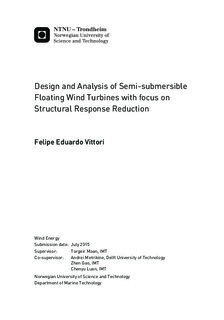| dc.description.abstract | Floating structures as spar, semi-submersibles and TLP have been proposed for offshore wind turbines for deep waters (>60m) according to the report of Arapogianni, Moccia, Williams, & Phillips (2011), where bottom fixed sub-structures are technically and economically not feasible. Several floating concepts have been designed and just some of them were deployed as Hywind (Statoil, 2015) and WindFloat (Roddier, Cermelli, Aubault, & Weinstein, 2010), but still they are prototypes that require further improvements in order to achieve it techno-economic feasibility.
At the Centre for Ships and Ocean Structures (CeSOS) NTNU a braceless concept was developed for deep waters called CSC. This floater consists on one central column supporting the wind turbine and three side columns connected each of them at the bottom to the central one through pontoons. These cantilever columns might induce large dynamic stress at the connection section on the pontoon as well on the cross section closer the central column.
The project objective is to propose a structural connection between the central and outer columns at the top avoiding wave loads and check its stress reduction on the pontoon.
The design methodology involves a stability analysis using numerical tool from Det Norske Veritas (DNV) Genie and HydroD. The wind turbine from the National Renewable Laboratories (NREL) in E.E.U.U. of 5MW was employed to estimate the loads and workability of the floater. The hydrodynamics analysis is going to be done in frequency domain based just in wave loads.
Through the hydrodynamic loads the stresses are estimated assuming rigid body behavior. It estimation are done by Euler-Bernoulli theory and via Finite Element Method using beams and shell elements.
The results show that the upper beams reduce significantly the dynamic axial stress on the pontoon, increasing the floater strength. The FEM using beam elements is a simple and reliable numeric approach to obtain global loads and the stress distribution on the structure. The FEM shell mode could predict the stress for the simplest case but it requires more computational effort in order to set up the mesh model and achieve satisfactory results.
The Euler-Bernoulli method under predict the stress on the pontoons as the whole structure of pontoon-brace does not fulfill the beam theory assumptions. | |

